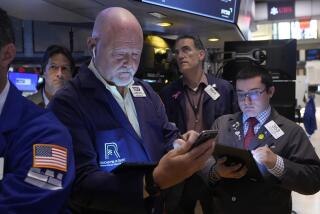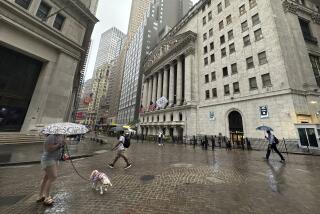Suspense builds at intermission
The stock market’s bull run is sputtering at midyear, with worries mounting that the woes of the U.S. housing sector are spilling into other areas of the economy and the financial markets.
The discovery of two car bombs in London on Friday also weighed on investors’ mood as the first half of 2007 ended.
For the moment, however, sellers haven’t done much damage to Wall Street overall: Despite a barrage of bad news in recent weeks, major market indexes are down just modestly from their recent highs.
Foreign markets, the stars of the year and the decade as well, also haven’t surrendered much of their recent gains.
On Friday, the Dow Jones industrials went on a wild ride to end the first half: The blue-chip index rallied 100 points early in the session, then sank to a loss of 108 points on the news from London before rallying again at the close to finish with a decline of 13.66 points, or 0.1%, to 13,408.62.
In the second quarter the Dow surged 8.5%. It is up 7.6% for the half.
The broader Standard & Poor’s 500 index, a benchmark for many investors’ portfolios, rose 5.8% in the quarter and 6% in the half. It eased 2.36 points, or 0.2%, to 1,503.35 on Friday.
After a first-quarter swoon triggered in part by a brief pullback in red-hot Chinese stocks, markets worldwide soared in the second quarter. On Wall Street the heady gains from March through early June were rooted in the belief that the U.S. economy was bouncing back from a first-quarter lull.
But with that bounce came higher long-term interest rates, which began to unnerve investors early this month. The yield on the 10-year U.S. Treasury note, a benchmark for mortgage and other long-term rates, hit 5.3% on June 12, a five-year high and up from 4.7% at year’s end.
And with the jump in rates came fears that the U.S. housing market would sink further, stoking more mortgage defaults by strapped homeowners. Those concerns deepened last week with the collapse of two Bear Stearns Cos. hedge funds that invested in high-risk bonds backed by sub-prime mortgages.
This week, Wall Street was chilled by the prospect of contagion. Suddenly, some buyout firms began to have trouble lining up cheap financing for takeover deals, as lenders balked.
“People are connecting the dots” of rising interest rates and how they can fuel trouble throughout the economy and markets, said Bernie Schaeffer, head of Schaeffer’s Investment Research in Cincinnati.
The Federal Reserve, however, is maintaining its view that the economy is on a steady growth path. At their meeting Thursday, policymakers held their key short-term rate steady at 5.25% -- its level for the last year -- and said “the economy seems likely to continue to expand at a moderate pace over the coming quarters.”
The Fed says its main concern is that inflation pressures won’t abate. Stubbornly high oil prices aren’t helping the inflation outlook: Near-term crude futures rose $1.11 to $70.68 a barrel Friday, the highest since August. Oil is up 16% year to date.
The silver lining for the stock market is that energy shares helped push key market indexes, including the S&P; 500, to record highs in the first half.
Of the 10 major industry groups in the S&P; index, energy was the best performer in the half, up 16.3%. Shares of oil-drilling services firm Schlumberger shot up 34.5%.
Yet investors bought stocks across the spectrum for much of the period, reflecting optimism about the economy, said Sam Stovall, investment strategist at S&P; in New York.
The second-best-performing S&P; 500 sector in the half was basic materials, which includes companies in such businesses as chemicals and mining. That group rose 15.5% in the period.
Technology stocks in the S&P; index gained 9% in the half, extending a strong rebound that began in the second half of 2006.
The tech-dominated Nasdaq composite index, which slipped 5.14 points, or 0.2%, to 2,603.23 on Friday, was up 7.5% in the second quarter and 7.8% in the half.
Just one of the 10 S&P; sectors was down in the half: Financial services stocks lost 2% in the period. Investors pulled away from interest-rate sensitive issues as long-term rates jumped. And Bear Stearns’ hedge-fund troubles have hammered shares of many big brokerages in recent weeks. Merrill Lynch stock is down 10.2% year to date.
Still, the broader market has largely held its ground. Stovall noted that the S&P; 500 index remains within 2.4% of its all-time closing high of 1,539.18 reached on June 4. In May, the index finally surpassed the peak it reached in 2000.
The Russell 2,000 index of small-company stocks, which lost 0.6% to 833.70 on Friday, is down 2.5% from its record high reached June 4.
And with economic growth in much of the rest of the world outpacing the U.S. this year, many foreign markets are again outperforming Wall Street. The German market surged 21.4% in the first half. Mexico’s market gained 17.8%.
The average foreign stock mutual fund is up 11.6% this year, according to Morningstar Inc. The average U.S. fund is up 7.7%.
But the next move in interest rates, which have been rising worldwide, could be crucial to the trend of stocks, analysts say.
On Friday the 10-year T-note yield pulled back to 5.03% from 5.11% on Thursday after a government index of consumer prices posted a smaller-than-expected rise in May.
If rates should turn higher again, that could spell more trouble for corporate takeover financing. Any decline in takeover activity would erode one of the major pillars holding up the stock market: The value of announced takeover deals involving U.S. companies totaled nearly $1 trillion in the first half, up about 50% from the same period in 2006, according to data firm Thomson Financial.
Another looming test for stocks: second-quarter earnings reports. Average year-over-year earnings growth for the S&P; 500 companies is projected by analysts to be in the mid-single digits. But first-quarter profit increases were twice as big as expected, boosted in part by companies’ foreign operations.
Despite the stock market’s resilience, even some bulls say a big risk now is that the huge debts that hedge funds, corporate buyout firms and other investors have taken on as part of their investment strategies in recent years could land more of them in financial trouble.
“Everybody’s looking for the next financial crisis,” said Liz Ann Sonders, chief investment strategist at Charles Schwab Corp. in New York. “But from a contrarian point of view, maybe that means it’s already priced into the market.”
--
(BEGIN TEXT OF INFOBOX)
Interest rates jump but stocks mostly hold up
--
Long-term bond yields surged in the second quarter amid expectations
of stronger economic growth. That optimism about the economy helped to
support the stock market’s advance.
*--* Pctg. change: Index 2nd qtr. YTD Dow industrials +8.5% +7.6% Nasdaq compos. +7.5% +7.8% NYSE compos. +6.6% +8.0% Dow transports +6.0% +11.8% S&P; 500 +5.8% +6.0% S&P; mid-cap +5.5% +11.3% S&P; small-cap +5.0% +8.1% Russell 2,000 +4.1% +5.8% Dow utilities --0.4% +9.1%
*--*
Source: Bloomberg News
More to Read
Inside the business of entertainment
The Wide Shot brings you news, analysis and insights on everything from streaming wars to production — and what it all means for the future.
You may occasionally receive promotional content from the Los Angeles Times.










